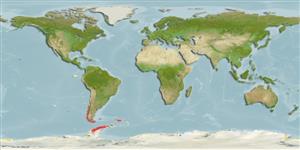Common names from other countries
Environment: milieu / climate zone / depth range / distribution range
Ecologie
; diepteverspreiding 10 - 610 m (Ref. 87801). Polar; 46°S - 74°S, 77°W - 35°W
Southeast Pacific and Antarctic Atlantic.
Length at first maturity / Size / Gewicht / Leeftijd
Maturity: Lm ? range ? - ? cm
This is a benthic mobile species found on primnoid gorgonians at depths of 10 to 610 m. It has a mouth capable of opening very wide, allowing it to prey on octocorals (Ref. 87801). Solitary (Ref. 2377).
Life cycle and mating behavior
Geslachtsrijpheid | Voortplanting | Kuitschieten | Eieren | Fecundity | Larven
Members of the class Anthozoa are either gonochoric or hermaphroditic. Mature gametes are shed into the coelenteron and spawned through the mouth. Life cycle: The zygote develops into a planktonic planula larva. Metamorphosis begins with early morphogenesis of tentacles, septa and pharynx before larval settlement on the aboral end.
Southern Ocean Mollusc Database (SOMBASE). 2011. (Ref. 87340)
Status op de Rode Lijst van het IUCN (Ref. 130435)
Status bij CITES (Ref. 108899)
Not Evaluated
Not Evaluated
Gebruik door de mens
| FishSource |
Tools
Meer informatie
Leeftijd/Grootte
Groei
Lengte-gewicht parameters
Lengte-lengte parameters
Morfologie
Larven
Abundantie
Internet-bronnen
Estimates based on models
Preferred temperature
(Ref.
115969): 0.5 - 9.8, mean 7.1 (based on 46 cells).
Prijsklasse
Unknown.
